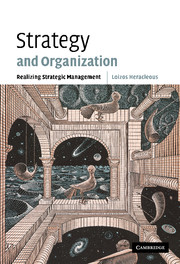Book contents
- Frontmatter
- Contents
- List of figures
- List of tables
- Preface
- I Bases of strategic management
- II Realizing strategy
- 5 The complexities of strategy implementation
- 6 Organizational culture and strategic change processes
- 7 The role of organizational discourse in understanding and managing strategic change
- 8 Strategic change processes: an organization development approach
- III Current themes and applications
- Index of names
- Index of subjects
- References
5 - The complexities of strategy implementation
Published online by Cambridge University Press: 11 May 2010
- Frontmatter
- Contents
- List of figures
- List of tables
- Preface
- I Bases of strategic management
- II Realizing strategy
- 5 The complexities of strategy implementation
- 6 Organizational culture and strategic change processes
- 7 The role of organizational discourse in understanding and managing strategic change
- 8 Strategic change processes: an organization development approach
- III Current themes and applications
- Index of names
- Index of subjects
- References
Summary
This chapter highlights the turbulence of the competitive environment, which makes capabilities for strategic thinking and successful realization of strategy even more critical. It addresses the high costs of failed implementation efforts, as well as the reasons for which strategy implementation efforts can fail. Finally, it outlines various concepts and frameworks that can aid successful strategy implementation.
Competencies for success in a turbulent world
Most consultants, management gurus, and academics exhibit a rare instance of agreement on the view that in order to achieve competitive success in the future, existing ways of competing and thinking are not enough; organizations have to learn to compete and think in new ways. Emerging strategic imperatives include goals of not just aiming to optimize within the organization's current industry but trying to generate ground-breaking strategies which will create new niches and markets and re-define whole industries Porter (1997). In other words, competing not just for market share in existing markets but for “opportunity share” in future markets, in a world of continuous re-definition of industry boundaries and commingling technologies Prahalad (1997). This means that companies should not merely or exclusively be trying to catch up with the best performers in current competitive games, but be aiming to invent new games, re-write the rules and create new competitive space Hamel (1997a). Competitive success favors companies that have taken bold approaches and re-written the conventional competitive rules of their industries Hamel (1997b; Kumar et al. 2000).
- Type
- Chapter
- Information
- Strategy and OrganizationRealizing Strategic Management, pp. 73 - 86Publisher: Cambridge University PressPrint publication year: 2003



